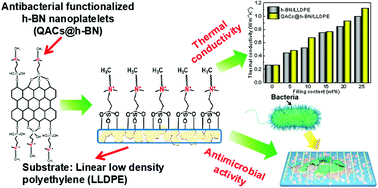Antimicrobial hexagonal boron nitride nanoplatelet composites for the thermal management of medical electronic devices
Abstract
Hospitals need adequately clean environments to avoid the growth of bacteria; however, most thermally conductive materials used as a housing for medical electronic devices provide an ideal substrate for bacterial growth. Herein, we grafted quaternary ammonium compounds (QACs) on the surfaces of h-BN nanoplatelets via hydroxylation to form functional fillers for linear low-density polyethylene (LLDPE); as expected, the results of the antimicrobial testing of the 25 vol% QACs@h-BN/LLDPE nanoplatelet composites showed approximately 100% growth inhibition against both E. coli and S. aureus bacteria. Also, the zone-of-inhibition test confirms that the disinfection method of QACs@h-BN/LLDPE nanoplatelet composites is contact killing without the release of biocides, which cause environmental pollution. Notably, morphology analyses (SEM) revealed that the introduction of organic chains onto h-BN also significantly improved the degree of interface combination with LLDPE, which promoted more efficient heat transfer. The thermal conductivity of the 25 vol% QACs@h-BN/LLDPE nanoplatelet composites could reach 1.115 W m−1 K−1; this value distinctly exceeded that of the unmodified h-BN/LLDPE nanoplatelet composites (0.926 W m−1 K−1). Moreover, the preparation strategy of this research is substrate independent; therefore, the modified QACs@h-BN nanoplatelets can be applied to a broad range of materials to prepare different types of thermally conductive and antimicrobial composite materials.



 Please wait while we load your content...
Please wait while we load your content...